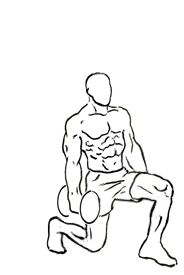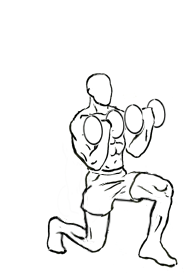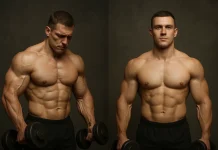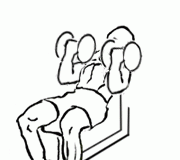Last Updated on September 30, 2014
The Forward Lunge with Bicep Curl using Dumbbells is a highly effective compound exercise that works both the lower body and upper body simultaneously. By combining a forward lunge with a bicep curl, this movement engages multiple muscle groups, including the quadriceps, glutes, hamstrings, and biceps, making it an ideal addition to full-body workouts. Not only does it improve strength, but it also challenges balance, coordination, and core stability.
Incorporating compound exercises like the Forward Lunge with Bicep Curl into your workout routine allows you to burn more calories in less time, enhance overall functional fitness, and build muscle more efficiently. This combination exercise is particularly beneficial for those looking to improve muscle endurance, tone their body, and work on strength training all at once.
In this blog, we will dive into the benefits of the Forward Lunge with Bicep Curl, provide a step-by-step guide on how to perform it with proper form, highlight common mistakes to avoid, and suggest variations to challenge yourself further. By the end, you’ll understand why this move is a powerhouse exercise that you’ll want to include in your routine, no matter your fitness level.
Why the Forward Lunge with Bicep Curl?
The Forward Lunge with Bicep Curl is a dynamic exercise that engages both the lower and upper body, helping to improve muscle coordination, strength, and balance. Here are a few key reasons why this exercise is a great addition to your workout routine:
- Works Multiple Muscle Groups: This exercise combines two movements—lunges for the lower body and curls for the upper body. As a result, it targets several muscle groups, including the quadriceps, hamstrings, glutes, calves, and biceps. By engaging multiple muscles, the exercise enhances overall strength and muscle definition in both the arms and legs.
- Improves Functional Fitness: Functional exercises, like the Forward Lunge with Bicep Curl, mimic real-life movements such as walking, bending, and lifting. This movement improves overall body coordination and balance, which translates to better performance in daily activities and sports.
- Burns More Calories: Because this is a compound movement involving both the upper and lower body, it increases your heart rate and burns more calories compared to isolated exercises like regular bicep curls or lunges alone. This makes it a time-efficient way to boost your metabolism and build muscle.
- Increases Core Stability: When performing a lunge, your core has to engage to maintain balance and prevent wobbling. Adding a bicep curl to the movement increases the demand on your core, helping to improve core strength and stability.
- Enhances Coordination and Balance: Lunges inherently require good balance, and when you add a bicep curl, it challenges your body to coordinate both movements at once. This improves your overall coordination, which is beneficial for athletic performance and injury prevention.
- Low Equipment Requirement: All you need for this exercise is a pair of dumbbells and enough space to lunge forward. It’s an accessible movement that can be performed at the gym or at home, making it easy to incorporate into various workout settings.
Muscles Worked in the Forward Lunge with Bicep Curl
This combination exercise primarily targets the following muscle groups:
- Quadriceps (Front Thighs): The quads are heavily engaged during the forward lunge as they are responsible for extending the knee and lowering your body into the lunge position. The quadriceps also work to push your body back up to the starting position.
- Glutes (Buttocks): Your glutes, particularly the gluteus maximus, play a key role in stabilizing your hips and helping you return to a standing position after lunging. This helps in shaping and strengthening the buttocks.
- Hamstrings (Back of the Thighs): The hamstrings assist in controlling the descent during the lunge and help extend the hip when you push back to the starting position.
- Calves (Lower Legs): The calves are activated to stabilize the ankle and foot during the forward lunge, helping you maintain balance.
- Biceps (Upper Arms): The bicep curl portion of the exercise directly targets the biceps brachii, the muscle responsible for flexing the elbow and bringing the dumbbells toward your shoulders. This helps strengthen and define your arms.
- Core (Abdominals and Lower Back): To maintain stability and prevent wobbling while performing the lunge and curl, your core muscles are actively engaged throughout the movement, helping to improve posture and balance.
Step-by-Step Guide to Performing the Forward Lunge with Bicep Curl
Equipment Needed:
- Dumbbells: Choose a pair of dumbbells that you can curl comfortably while maintaining proper form during the lunge. Beginners may want to start with lighter weights and gradually increase the load as strength improves.
Starting Position:
- Stand Upright with Dumbbells in Hand: Begin by standing tall with your feet together, holding a dumbbell in each hand with your arms fully extended down by your sides. Your palms should be facing up in a supinated grip, as this position sets you up for the bicep curl portion of the exercise.
- Engage Your Core: Draw in your abs to stabilize your torso and maintain a straight posture. Your chest should be lifted, and your shoulders should be relaxed but pulled back.
The Movement:
- Step Forward into a Lunge: Take a controlled step forward with your right leg, ensuring that your foot lands firmly on the ground. As you step forward, bend both knees to lower your body into the lunge position. Your front thigh should be parallel to the ground, with your knee positioned directly over your ankle, not extending past your toes. The back knee should hover just above the floor but should not touch it.
- Perform a Bicep Curl: As you lower into the lunge, simultaneously curl both dumbbells toward your shoulders, bending your elbows to perform a bicep curl. Be sure to keep your elbows close to your sides and your wrists straight to maximize bicep engagement. Focus on squeezing your biceps at the top of the curl.
- Return to the Starting Position: Push off your front leg and bring your right foot back to the starting position, straightening both legs. At the same time, lower the dumbbells back down to your sides with control. Ensure that your body remains upright and your core stays engaged to maintain balance.
- Switch Legs: After completing the lunge and curl on the right leg, repeat the movement with your left leg. Alternate legs with each repetition, completing the desired number of reps on each side.
Tips for Proper Form and Technique
- Maintain an Upright Posture: Keep your torso straight and avoid leaning forward or arching your back. Engaging your core throughout the exercise will help maintain proper posture and protect your lower back.
- Control the Movement: Perform both the lunge and the curl in a slow and controlled manner. Rushing through the movement can lead to poor form, reducing the effectiveness of the exercise and increasing the risk of injury.
- Don’t Let Your Knee Pass Your Toes: When lunging forward, ensure that your front knee stays directly over your ankle. Allowing your knee to move too far forward can place unnecessary stress on your joints.
- Engage Your Core: Keep your abdominal muscles engaged to maintain balance and prevent excessive swaying or wobbling, especially as you transition from the lunge back to the starting position.
- Focus on the Bicep Contraction: When curling the dumbbells, concentrate on squeezing your biceps at the top of the movement. This helps maximize muscle engagement and promotes better bicep development.
- Use a Full Range of Motion: Lower your body into a deep lunge so that your front thigh is parallel to the floor. At the same time, fully extend your arms at the bottom of the curl and bring the dumbbells all the way up to your shoulders at the top.
Common Mistakes to Avoid
Here are some common mistakes people make when performing the Forward Lunge with Bicep Curl, along with tips on how to avoid them:
- Letting the Back Knee Hit the Ground: While lowering into the lunge, it’s important to avoid letting your back knee touch or slam into the ground. Keep the back knee hovering just above the floor to protect your knee and maintain tension in your muscles.
- Using Momentum: Swinging the dumbbells or using momentum to perform the curl can reduce bicep engagement. Focus on performing the curl slowly and with control to ensure that your biceps are doing the work.
- Leaning Forward: Leaning forward during the lunge can put unnecessary strain on your lower back and take the focus away from your legs. Keep your torso upright and your core engaged throughout the movement.
- Overloading the Weight: Using dumbbells that are too heavy can compromise your form, especially when combining the lunge and curl. Start with a weight that allows you to perform both movements with proper technique and increase the load gradually as you build strength.
Variations of the Forward Lunge with Bicep Curl
To keep your workouts interesting and challenge your muscles in different ways, try incorporating these variations of the Forward Lunge with Bicep Curl:
- Alternating Reverse Lunge with Bicep Curl: Instead of stepping forward into the lunge, step backward. The reverse lunge places more emphasis on the glutes and hamstrings while still working the biceps during the curl.
- Walking Lunge with Bicep Curl: The Walking Lunge with Bicep Curl adds an element of constant movement, increasing the cardiovascular demand of the exercise. Instead of returning to the starting position after each lunge, continue walking forward, performing a bicep curl with each step. This variation helps improve balance, endurance, and coordination.
- Lateral Lunge with Bicep Curl: In this variation, step out to the side instead of forward, performing a lateral lunge. This targets the inner thighs and hips, offering a new angle to challenge your legs and core, while still engaging your biceps with the curl.
- Curtsy Lunge with Bicep Curl: This variation involves stepping one leg behind and across your body, similar to a curtsy, before performing the bicep curl. The curtsy lunge targets the glutes, particularly the gluteus medius, while adding an element of balance and coordination.
- Hammer Curl with Lunge: Instead of performing a traditional bicep curl, switch to a hammer curl, where your palms face each other throughout the movement. This variation emphasizes the brachialis muscle and forearms, providing a different stimulus for arm growth.
- Weighted Lunge Hold with Bicep Curl: For a more intense challenge, hold the lunge position at the bottom while performing multiple bicep curls. This variation forces your legs to work harder to maintain the lunge, increasing the time under tension for both your legs and arms.
How to Incorporate the Forward Lunge with Bicep Curl into Your Routine
The Forward Lunge with Bicep Curl can be included in various workout routines, depending on your fitness goals. Here are a few ways to integrate it effectively:
- Full-Body Workouts: Incorporate the Forward Lunge with Bicep Curl as part of a full-body workout. This compound exercise ensures that both your upper and lower body are engaged, making it a time-efficient way to target multiple muscle groups.
- Leg and Arm Focused Workouts: On days when you’re focusing on legs and arms, use this movement to combine both muscle groups in one exercise. Pair it with other leg exercises like squats or lunges and arm exercises like tricep dips or shoulder presses.
- Supersets: To increase the intensity of your workout, try supersetting the Forward Lunge with Bicep Curl with a complementary exercise. For example, you can pair it with push-ups, Romanian deadlifts, or plank variations to keep your heart rate elevated while engaging different muscle groups.
- Circuit Training: Include this movement in a circuit to build endurance and keep your body moving. For instance, you can combine it with cardio exercises such as jump squats, mountain climbers, or kettlebell swings for a high-intensity workout.
- As a Finisher: Use the Forward Lunge with Bicep Curl as a finisher to fully exhaust both your upper and lower body muscles at the end of your workout. Perform multiple repetitions with lighter weights to maximize the burn in your biceps and legs.
Sample Full-Body Workout Incorporating Forward Lunge with Bicep Curl
Here’s an example of a full-body workout that includes the Forward Lunge with Bicep Curl:
- Warm-Up: 5–10 minutes of light cardio (e.g., jogging or cycling) followed by dynamic stretching.
- Squats: 4 sets of 10–12 reps.
- Forward Lunge with Bicep Curl: 3 sets of 10–12 reps per leg, focusing on control and proper form.
- Push-Ups: 3 sets of 12–15 reps.
- Dumbbell Row: 3 sets of 10–12 reps per arm.
- Plank with Alternating Shoulder Taps: 3 sets of 30–45 seconds.
- Cool Down: Static stretching focusing on the legs, arms, and core.
This workout targets all major muscle groups while incorporating the Forward Lunge with Bicep Curl for a well-rounded, strength-building session.
Benefits of Consistent Forward Lunge with Bicep Curl Training
- Increased Strength and Muscle Tone: The combination of lunging and curling with dumbbells helps build strength and tone muscles in both your upper and lower body, leading to more defined arms and legs over time.
- Improved Functional Fitness: This compound movement enhances your ability to perform real-world activities by improving balance, coordination, and strength across multiple muscle groups.
- Time-Efficient Full-Body Workout: By working several muscle groups at once, the Forward Lunge with Bicep Curl allows you to get more done in less time, making it ideal for those with busy schedules who still want to train effectively.
- Better Balance and Coordination: Lunging requires balance and stability, and adding the bicep curl increases the need for coordination between your upper and lower body, improving your overall athletic performance and reducing the risk of injury.
- Core Engagement and Stability: Engaging your core to maintain stability during this exercise helps strengthen your abs and lower back, contributing to better posture and overall core stability.
- Enhanced Calorie Burn: Compound exercises like the Forward Lunge with Bicep Curl raise your heart rate and burn more calories compared to isolated movements, making this an effective addition to weight loss or fitness programs.
The Forward Lunge with Bicep Curl using Dumbbells is a powerful, functional exercise that combines lower body strength with upper body muscle engagement. By incorporating both lunges and bicep curls, this movement targets multiple muscle groups, improves balance, and challenges your coordination, making it an essential addition to any workout routine.
Whether you’re aiming to build strength, improve muscle tone, or enhance your overall fitness, this compound exercise will help you reach your goals. Focus on proper form, control the movement, and gradually increase the weight to make the most out of this combination. As you get stronger, consider adding variations to keep your workouts challenging and engaging.
Next time you’re at the gym or working out at home, grab a pair of dumbbells and give the Forward Lunge with Bicep Curl a try. It’s a versatile, efficient, and effective way to build a stronger, more balanced body.








